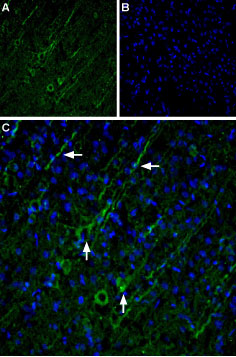Overview
- Peptide (C)HKWGDGQEEQVTTRL, corresponding to amino acid residues 959-973 of human TRPC5 (Accession Q9UL62). Intracellular, C-terminus.

 Western blot analysis of rat brain membranes:1. Anti-TRPC5 Antibody (#ACC-020), (1:200).
Western blot analysis of rat brain membranes:1. Anti-TRPC5 Antibody (#ACC-020), (1:200).
2. Anti-TRPC5 Antibody, preincubated with TRPC5 Blocking Peptide (#BLP-CC020).
- Rat neonatal ventricular cardiomyocytes (Sabourin, J. et al. (2016) J. Biol. Chem. 291, 13394.).
 Expression of TRPC5 in rat cortexImmunohistochemical staining of rat cortex using Anti-TRPC5 Antibody (#ACC-020). A. TRPC5 immunoreactivity (green) appears in pyramidal shaped neuronal soma (vertical arrows) and apical dendrites (horizontal arrows). B. Nuclear staining using DAPI as the counterstain (blue). C. Merged image of A and B.
Expression of TRPC5 in rat cortexImmunohistochemical staining of rat cortex using Anti-TRPC5 Antibody (#ACC-020). A. TRPC5 immunoreactivity (green) appears in pyramidal shaped neuronal soma (vertical arrows) and apical dendrites (horizontal arrows). B. Nuclear staining using DAPI as the counterstain (blue). C. Merged image of A and B.- Rat substantia nigra (De March, Z. et al. (2006) Neurosci. Lett. 402, 35.).
- Human U373 MG cells (1:120) (Barajas, M. et al. (2008) J. Neurosci. Res. 86, 3456.).
- Moran, M.M. et al. (2004) Current Opin. Neurobiol. 14, 362.
- Clapham, D.E. et al. (2003) Pharmacol. Rev. 55, 591.
- Clapham, D.E. (2003) Nature 426, 517.
- Padinjat, R. and Andrews, S. (2004) J. Cell. Sci. 117, 5707.
- Huang, C.L. (2004) J. Am. Soc. Nephrol. 15, 1690.
- Liu, X. et al. (2003) J. Biol. Chem. 278, 11337.
The Transient Receptor Potential (TRP) superfamily is one of the largest ion channel families and consists of diverse groups of proteins. In mammals about 28 genes encode the TRP ion channel subunits. The mammalian TRP superfamily comprises six subfamilies known as the TRPC (canonical), TRPV (vanilloid), TRPM (melastatin), TRPML (mucolipins), TRPP (polycystin) and the TRPA (ANKTM1) ion channels.1-4
The TRPC subfamily consists of seven proteins named TRPC1 to 7 which can be further divided into four subgroups based on their sequence homology and functional similarities:
1) TRPC1
2) TRPC4 and TRPC5
3) TRPC3, TRPC6, TRPC7
4) TRPC2.2,5
They are highly expressed in the central nervous system and to a lesser extent in peripheral tissues.
TRPC5 channels are assumed to form components of store operated channels in some cell types such as salivary gland cells, endothelial cells and vascular smooth muscle cells, and can be activated either by calcium store depletion or by GPCR stimulation pathways.6
Application key:
Species reactivity key:
Anti-TRPC5 Antibody (#ACC-020) is a highly specific antibody directed against an epitope of the human protein. The antibody can be used in western blot, immunoprecipitation, immunocytochemistry, and immunohistochemistry applications. It has been designed to recognize TRPC5 from mouse, rat, and human samples.

Expression of TRPC5 in rat nodose ganglion.Immunohistochemical staining of rat nodose ganglion sections using Anti-TRPC5 Antibody (#ACC-020). TRPC5 staining (green) is detected in the somata of sensory neurons. TRPC5 staining co-localizes with PGP9.5 neuronal marker. Shown is a control experiment without the primary antibody.Adapted from Lau, O.C. et al. (2016) Nat. Commun. 7, 11947. with permission of Nature Publishing Group.
Applications
Citations
- Western blot analysis of mouse primary mesenteric endothelial cell (MMEC) lysate. Tested in TRPC5-siRNA treated cells.
Zhu, Y. et al. (2019) J. Biol. Chem. 294, 28.
- Mouse primary mesenteric endothelial cell (MMEC) lysate. Also tested in TRPC5-siRNA treated cells.
Zhu, Y. et al. (2019) J. Biol. Chem. 294, 28. - Rat pulmonary artery lysate.
Jiang, H.N. et al. (2016) Biomed. Pharmacol. 82, 20. - Rat neonatal ventricular cardiomyocytes (1:200).
Sabourin, J. et al. (2016) J. Biol. Chem. 291, 13394.
- Rat neonatal ventricular cardiomyocytes.
Sabourin, J. et al. (2016) J. Biol. Chem. 291, 13394.
- Rat substantia nigra.
De March, Z. et al. (2006) Neurosci. Lett. 402, 35.
- Rat primary cultured fetal and neonatal ventricular myocytes (1:100).
Jiang, Y. et al. (2014) Cell Tissue Res. 355, 201. - Human U373 MG cells (1:120).
Barajas, M. et al. (2008) J. Neurosci. Res. 86, 3456.
- Lau, O.C. et al. (2016) Nat. Commun. 7, 11947.
- He, Z. et al. (2012) J. Neurosci. 32, 9383.
- Yoshida, J. et al. (2005) Eur. J. Pharmacol. 510, 217.
- Facemire, C.S. et al . (2004) Am. J. Physiol. 286, F546.
